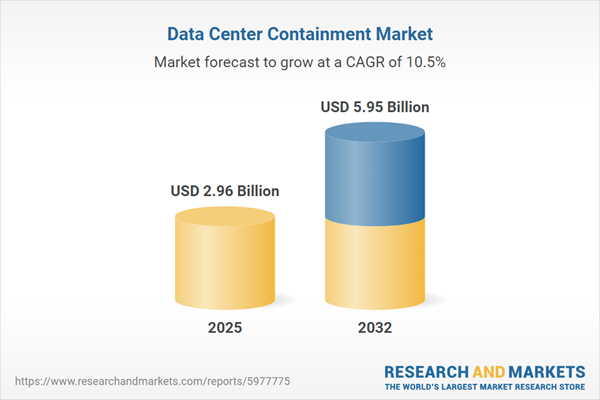Speak directly to the analyst to clarify any post sales queries you may have.
Enterprises undertaking digital transformation must prioritize secure, sustainable, and resilient data centers to support business continuity, regulatory compliance, and future growth. Senior decision-makers are increasingly looking to the data center containment market as a strategic lever to enhance operational reliability and ensure regulatory alignment in the evolving digital landscape.
Market Snapshot: Data Center Containment Market Trends and Growth
In 2024, the data center containment market reached a value of USD 2.68 billion, on track to achieve USD 2.96 billion in 2025 and a projected USD 5.95 billion by 2032, reflecting a 10.47% compound annual growth rate. The increasing use of advanced containment systems is enabling organizations to address the needs of modern data centers by optimizing airflow, improving cooling effectiveness, and aligning with sustainability expectations. As facility designs shift toward energy-efficient models, these solutions play an instrumental role in achieving compliance and maximizing operational outcomes across both new builds and legacy environments.
Scope & Segmentation: Key Elements of the Data Center Containment Market
A clear view of the data center containment market enables executives to align investment priorities with operational and regulatory objectives. Segmentation across the industry provides measurable outcomes in efficiency, risk management, and adaptability. Key segments influencing the current landscape include:
- Containment Types: Cold aisle, hot aisle, overhead, and underfloor containment structures optimize airflow in both new and retrofitted facilities, offering improved thermal control and enabling scalable expansion.
- End Users: Colocation providers, government bodies, financial institutions, healthcare organizations, hyperscale operators, and IT firms leverage containment for privacy, regulatory adherence, and varying operational goals.
- Data Center Sizes: Modular and flexible containment solutions address the demands of diverse facility sizes, from smaller upgrades to expansive enterprise sites, supporting dynamic resource utilization.
- Component Innovations: Advanced elements such as integrated doors, blanking panels, roofs, side panels, gaskets, end caps, and seals contribute to targeted airflow control for enhanced cooling across a range of configurations.
- Regional Dynamics: Adoption patterns in North America, Europe, Asia-Pacific, the Middle East, and Africa reflect variations in energy standards, regulatory pressure, and supplier networks, influencing strategic entry and investment decisions.
- Technology Adoption: Solutions like intelligent cooling, automated air management, IoT-powered sensors, and liquid-assisted systems enable real-time performance monitoring and responsiveness to shifting operational challenges.
- Market Leaders: Organizations such as Schneider Electric SE, Vertiv Group Corp., Rittal GmbH & Co. KG, Chatsworth Products LLC, STULZ GmbH, Airedale International Air Conditioning Ltd, Eaton Corporation plc, ABB Ltd, Legrand S.A., and Delta Electronics, Inc. are shaping industry practices, design benchmarks, and the pace of technical innovation.
Key Takeaways for Data Center Containment Strategies
- Adopting targeted containment approaches enhances temperature stability and supports broader sustainability and compliance initiatives for varied facility types.
- Implementing modular, flexible containment allows seamless integration with emerging digital systems—such as AI and cloud deployments—equipping organizations to manage fluctuating workloads and operational demands.
- Retrofitting containment in legacy data centers delivers notable gains in environmental efficiency, helping unlock value from existing assets and delaying capital investments in new infrastructure.
- Partnerships among suppliers, service firms, and researchers streamline the adoption of best practices, helping organizations adapt to regulatory shifts and manage workload volatility.
- Sectors facing stringent privacy and regulatory challenges, including finance, healthcare, and the public sector, benefit from containment solutions tailored to address complex security and risk management needs.
- Enhanced oversight via digital twins and IoT-based monitoring supports proactive management, enabling continuous optimization and reliability in changing operational environments.
Tariff Impact: Navigating Supply Chain Challenges in 2025
Tariffs on steel, aluminum, and electronic components in the United States are prompting firms to revise sourcing tactics. These changes focus on partnering with regional suppliers and refining procurement strategies to achieve material consistency and cost stability. Such measures are critical in minimizing uncertainty and safeguarding project timelines for large-scale and older data center sites.
Methodology & Data Sources
This analysis draws upon contributions from operators, manufacturers, consultants, and regulatory authorities, combined with comprehensive market research and compliance trend assessment. Methodologies such as SWOT analysis and Porter’s Five Forces inform the insights, ensuring relevance for strategic leadership.
Why This Report Matters for Senior Decision-Makers
- Supports leadership in aligning containment strategies with business priorities, regulatory frameworks, and long-term value creation.
- Offers insights for managing supply risk, streamlining procurement, and adapting to dynamic policy or market conditions.
- Equips enterprises to develop resilient and future-proof data center infrastructure through best practice and technological adoption.
Conclusion
Senior leaders can leverage these insights to refine containment strategies, maintain agility amid changing requirements, and support robust operations as digital transformation evolves.
Additional Product Information:
- Purchase of this report includes 1 year online access with quarterly updates.
- This report can be updated on request. Please contact our Customer Experience team using the Ask a Question widget on our website.
Table of Contents
3. Executive Summary
4. Market Overview
7. Cumulative Impact of Artificial Intelligence 2025
Companies Mentioned
The companies profiled in this Data Center Containment market report include:- Schneider Electric SE
- Vertiv Group Corp.
- Rittal GmbH & Co. KG
- Chatsworth Products, LLC
- STULZ GmbH
- Airedale International Air Conditioning Ltd
- Eaton Corporation plc
- ABB Ltd
- Legrand S.A.
- Delta Electronics, Inc.
Table Information
| Report Attribute | Details |
|---|---|
| No. of Pages | 186 |
| Published | October 2025 |
| Forecast Period | 2025 - 2032 |
| Estimated Market Value ( USD | $ 2.96 Billion |
| Forecasted Market Value ( USD | $ 5.95 Billion |
| Compound Annual Growth Rate | 10.4% |
| Regions Covered | Global |
| No. of Companies Mentioned | 11 |









